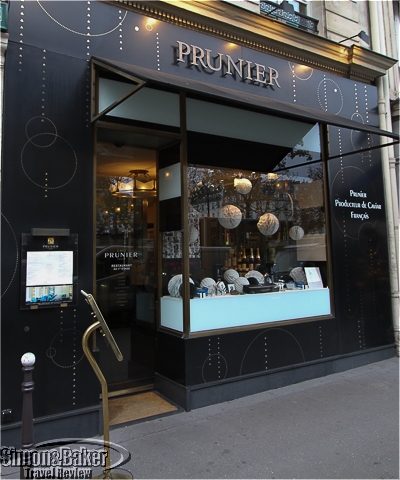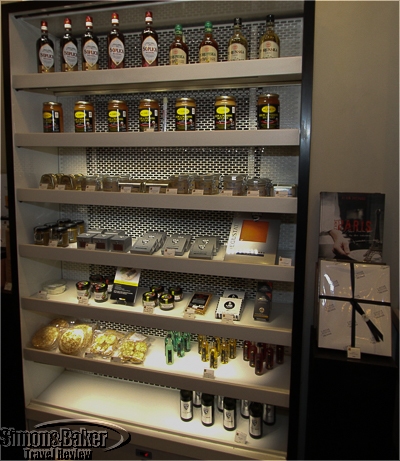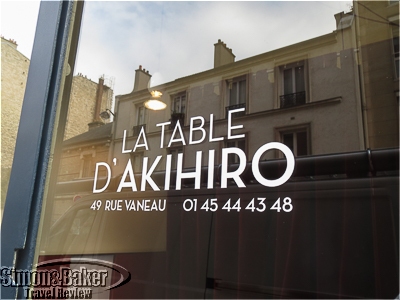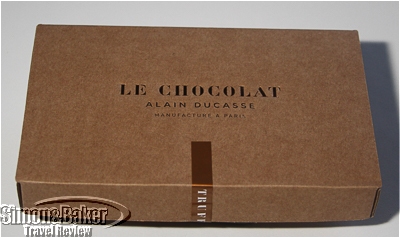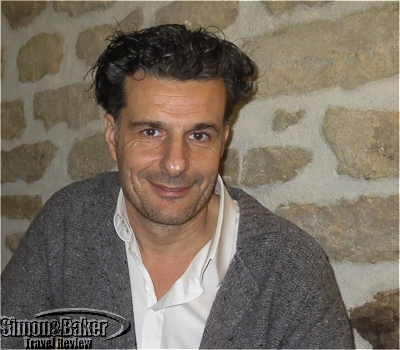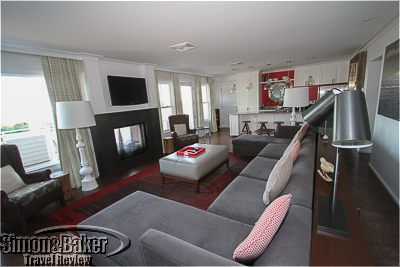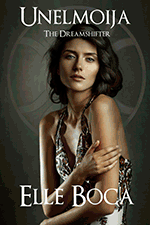Luxury Travel Review

A caviar and salmon tasting in Paris
By Elena del Valle and photos by Gary Cox
The Prunier shop on Place de la Madeleine, Paris
Inside the Prunier shop – click to enlarge
Tasting more than one type of caviar at a time is not ideal, the sales lady at Prunier, a specialty shop on the ritzy Place de la Madeleine in Paris, France, said when I asked about sampling several varieties of the delicate seafood. She went on to explain that most people’s palate has trouble distinguishing the flavors in the same way that after sampling several wines it becomes difficult to taste the nuances of each consecutive one.
The Prunier shop had a selection of caviar cans on display.
So it was that we settled on only one kind of the four caviar types sold at the shop instead of the two or more varieties we had anticipated when we planned a caviar tasting. We also sampled some Norwegian farm raised Balik salmon which she said tasted “like candy.”
The Prunier Tradition Caviar we sampled. (click to enlarge)
She recommended the Tradition Caviar, explaining that it accounted for as much as 60 percent of the company’s caviar production. Ours was from the most recent production of September 2014 and had been aged one month. We took home a 30 gram tin of Tradition, a farmed caviar from Montpon Menesterol in France, for each of us. We also took a 120 gram vacuum pack of Balik Norwegian farmed salmon smoked in Ebersol, Switzerland. They came in insulated sealed plastic bags with small frozen packs.
A box of Balik salmon for one.
The products would be at their best if we refrigerated them within five hours so we made our way back to our place with alacrity, arriving within an hour and placing the bags in the refrigerator immediately. They sat in the corner while we fretted with anticipation until the following afternoon when we sampled them with a glass of well chilled brut champagne.
The salmon display case with a variety of cuts and sizes.
Following her advice we had the caviar by itself first. It was buttery with a pleasing texture, a mild flavor and just the right amount of salt to highlight its natural taste without being too salty. There was also a hint of nuttiness and a pleasant aftertaste but no fishiness.
There was a case containing other products like foie gras and blinis.
The salmon too was subtle and had a buttery melt-in-your-mouth texture. We sliced it into bite size chunks and ate it by itself with no garnishes or condiments. Each package was a single serving which was plenty, yet it seemed to disappear as if by magic. I would buy both products again and recommend them to friends, especially if it is their first time tasting caviar and salmon. Boutique Prunier (15 place de la Madeleine, 75008 Paris, France, +33 147429898, www.prunier.com, info@prunier.com), a 50 square meter ground level shop, was established in 2005.
Some of our Paris food favorites
By Elena del Valle and photos by Gary Cox
A unique view of Paris from atop Notre Dame. (click to enlarge)
Paris, France is an exceptional city when it comes to restaurants and food. In addition to a variety of neighborhood size supermarket stores, specialized food shops small and large, single and chain owned, domestic and foreign can be found across the city. As if that wasn’t enough street market vendors sell fresh seafood, ethnic foods, produce, flowers, dairy products and merchandise several times a week in various city neighborhoods.
A variety of salts at the Galeries Lafayette Maison
Yuzu citrus from Japan
Prices are high and the shelf life of fresh products short so it pays to shop often and with care, and to pay attention when making purchases lest the produce wilt or spoil in the refrigerator before we consume it. Over the years we have discovered that the best way to shop for us is to pick and choose favorite products from a variety of vendors in our area. For example, we usually find a neighborhood bakery and grocer for regular purchases. In addition, for special occasions and when we just want to treat ourselves to something out of the ordinary there are a number of sellers we find are worth a special trip or detour.
The Bellota Bellota shop and eatery in the Latin Quarter
Slicing bellota ham requires skill (click to enlarge)
For over the top wonderful bellota ham from Spain and related products we like the Bellota Bellota store on rue de Seine in the Latin Quarter (see Paris Latin Quarter gourmet shop new favorite). They offered eat in (though we found it too chilly to eat there on cold days) and take out options as well as freshly sliced and vacuum packed options. Most recently we tried Le Royal sandwich made with slices of master cortador cut bellota, manchego cheese and homemade smashed tomatoes. The single slice of cheese and single slice of bellota tasted best after removing one of the halves of the thick and crunchy bread.
The distinctive Marriage Freres sign marked the location of fine teas
A turkey club at the Carrousel du Louvre location of Mariage Freres
When we are in the mood for tea and a light meal at a teashop we make our way to Mariage Freres on rue Bourg-Tibourg in the Right Bank for their Snob Salad and Louvre sandwich (see Superb gourmet lunch at Paris tea salon). Although on our most recent visit the service was slower and less attentive in the tea salon and shop by far than in past occasions the food was good. We generally stay away from the too touristy Carrousel du Louvre location, especially in cold weather. We have found the underground shopping center next to the Louvre Museum to be overcrowded, and the only bathroom for teashop customers was an equally crowded pay for use mall facility outside the eatery. Although clean and maintained by onsite staff it required exiting the tea shop and walking over public bathroom, payment of 1.50 euros and standing in line.
The Snob Salad at the Grand Augustin shop (click to enlarge)
A cup of matcha tea whipped and served in a special cup
On our most recent stay in the City of Lights, we visited the shop and tea salon at Grands Augustins on the Left Bank. While we were disappointed the shop did not carry the match tea flavor we liked from the tea salon or offer any date for its availability (the staff person responded stiffly when we asked) the tea salon experience was pleasant and the service attentive. The Snob Salad was slightly different and less to our liking than the one on rue Bourg-Tibourg.
Table D’Aki changed its name to La Table d’Akihiro
The scallops with white truffles were outstanding
A delicate fish served with caramelized endive (click to enlarge)
For dependable, fresh, beautifully prepared and presented seafood we beeline our way to Table d’Akihiro in the Left Bank (see Same outstanding seafood Paris restaurant, updated name). While advance reservations have been a must, and menu selection in the past was limited to one or two appetizers, one or two mains and one dessert, the meals have always been exceptional and outstanding value for money.
Alain Ducasse new Left Bank shop worth a visit for single source dark chocolate
By Elena del Valle
Photos by Gary Cox
Le Chocolat storefront on Rue Saint-benoite
Paris, France is a city where many bakeries sell chocolates and specialized chocolate shops abound. Some shops sell handmade chocolates made onsite while others tout imported bonbons. Some vendors, especially in tourist areas, attract buyers with elaborate chocolate art and sculptures, sparsely stocked display cases, uniformed and gloved staff, and the high prices that might mean high quality, but don’t necessarily deliver on the implied promises.
Inside the store there was information and a display of the raw ingredients for chocolate (click to enlarge)
With such a plethora of choices what makes one chocolate seller rise above the rest despite simple, some might say understated, wrapping and boxes? Chocolates, especially single source dark chocolate bars, made from scratch in the shop’s own factory with organic ingredients. At this newly opened shop there were no artificial or from frozen ingredients, flavor enhancers, additives or preservatives in the products. In December 2013 we featured the factory (see The art of making chocolate Alain Ducasse style in Paris).
Specialty chocolate gift items in the window display
On our most recent visit to the City of Lights we discovered Le Chocolat Alain Ducasse’s new Left Bank location on a side street off the famed Boulevard Saint Germain (26, rue Saint-benoit, 75006, Paris, +33 01 45 48 87 89, http://www.lechocolat-alainducasse.com, contact@lechocolat-alainducasse.com). We returned often during our stay.
A video about the making of the chocolate ran on a screen (click to enlarge)
A chocolate spread and hot chocolate mix display (click to enlarge)
Opened in March 2014 the 30 square meter shop was owned by Alain Ducasse, he of the culinary empire. Despite the unobtrusive facade (we almost missed it on our first visit due to nearby construction) the shop was busy every time we were there. We were so distracted browsing the chocolate filled shelves and display cases on either side we almost missed the wall mounted television screen with presentations on the factory and manufacturing process, and the pretty original tiled floor.
Note the chocolate bars on display and the historic tile floor (click to enlarge).
A glass covered display case housed a variety of chocolate covered bonbons (click to enlarge).
On sale in a tall wall case, in brown paper foil lined resealable bags, were 48 varieties of chocolate bars. The design on the bars, available in 100 percent (only one), 75 percent, 65 percent, and 45 percent, was by Pierre Tachon. On the opposite side of the shop, there were also 25 types of bonbons, dragées, roc’s, soveria candied fruits, chocolate chips and chocolate spread (in glass jars) all made at the city factory in the eleventh arrondisement.
Chocolate made from Cuban Trinitario and Criollo beans
Chocolate and hazelnut spread
Under the careful supervision of the factory staff, the products were manufactured from cacao imported from small farms in 13 countries: Ecuador, Venezuela, Peru, Madagascar, Mexico, Granada, Sao Tome, Java, Dominican Republic, Trinidad, Vietnam, Cuba, and Brazil. To sweeten the brown paste the makers used organic non refined sugar. Italian artisan candied fruits were added to some bars including the muesli chocolate. The milk chocolate muesli chocolate bars, Mendiant Lacte Muesli 45 percent, quickly became my favorite item. Like the truffles and pralines they had a relatively short shelf life compared to the dark chocolate bars, but that was never a problem as they didn’t last long. I can’t wait to return to Paris to buy a stack.
A favorite: milk chocolate with muesli
Peruvian chocolate that had not been conched
We sampled the chocolate spread, and a box each of truffles and praline chocolates. From the chocolate bars we had mostly plain dark chocolate varieties although the Fourree made with coconut and passion fruit filling was another favorite. The single source bars we tried were 75 percent dark chocolate Venezuela Porcelana Criollo (a favorite with a sweet and tart finish), Sao Tome Forastero Amelonado, Cuba Trinitario Criollo (satisfyingly dark without being too sharp), Tradition Perou Non Conche (a favorite from our previous tasting, it was slightly gritty yet rewarding), and Bresil Trinitario. The Brazilian had a dark flavor with hints of tobacco while the Sao Tome was tart with a touch of spice. The Brazilian and Cuban flavors were new and was the 100 percent Peruvian chocolate bar. We tried 100 percent Perou Trinitario, made exclusively from Peruvian cacao. It was sharp and bitter, an acquired taste.
Various chocolate truffles coated with cocoa powder
The truffles came in a cardboard box
Kudos to Alain Ducasse and Nicolas Berger, the passionate man behind the chocolate factory, for their artisanal chocolate products, in particular the single source dark chocolate bars (and muesli milk chocolate bars for milk chocolate fans) worthy of a detour.
Burgundian led Paris wine tasting workshop in English was engaging
Article and photos by Elena del Valle
The entrance to Wine Tasting in Paris on an old cobblestone street
Understanding and appreciating wine is a personal and subjective experience, one I always feel the need to improve. Each time an opportunity presents itself for me to grow my knowledge and exposure to wines I jump on it. And what better place than Paris, France while I had time to spare? When I heard about a new program in English I was immediately interested. Hosted by Thierry Givone, a native of Burgundy, the French Wine Tour, a two hour hands on workshop was engaging and fun. Thanks to its central location I was able to walk there from my temporary Parisian home.
Thierry Givone, a native of Burgundy, hosted wine tasting workshops in English.
Following self introductions and a brief video presentation by our host, six of us, all Americans coincidentally (while Americans represent half of his clientele, many British, Canadians, Australians, and Europeans attend as well) tasted and discussed six wines ranging in retail price between 12 and 20 euros. They were, Champagne Brut Reserve from Thierry Massin; Sauvignon blanc Eclat de Silex, from Domaine Michaud, in Loire Valley 2013; Chardonnay Macon La Roche Vineuse from Domaine Merlin in Burgundy 2013; Pinot Noir Mercurey from Chateau de Santeney 2009; Bordeaux Chateau D’arcins Haut Medoc Cru Bourgeois 2011; and ORTAS, From Caves de Rasteaux, in Rhone Valley 2012.
The main area of Wine Tasting in Paris (click to enlarge)
Givone relied on a flat screen television for his presentation.
“I hope the quality of my welcome, from the confirmation e-mail to the recommendation of what to do or where to go after the tasting,” said Givone when asked what makes his programs special in a city filled with wine and gourmet tasting possibilities. “Individual interaction, the fact that I created the company and I animate all tastings myself, with passion and involvement, when other companies just drive the business and hire free lance sommelier for the animation. The atmosphere of my space, in this nice street, with a small tasting room where people feel very well. I’ve tried to create a ‘tour’ with a good combination of global information, details, historical facts, fun facts, and personal experience, so that people have learned things and had a great moment.”
The champagne selection from Thierry Massin
Givone’s first job was as marketing manager in a French subsidiary of an American group. In 2013, he established Wine Tasting In Paris (14 Rue des boulangers, 75005 Paris, France, + 33 676 933 288, www.wine-tasting-in-paris.com, thierry@wine-tasting-in-paris.com) at another location. The course I attended took place in a 45 square meter two room space within a building that may date to the XVII century, near metro stations Cardinal-Lemoine and Jussieu. The cobble stoned street itself was already in existence in 1350.
We spent most of the time at the table, watching the presentation and tasting wines. (click to enlarge)
We each had wine glasses, bread and water within reach.
Givone, a fan of wines from his native Burgundy, rounded his wine education by spending time at Wine and Spirit Education Trust (WSET) at the Ecole du Vin in Paris, Wine School of Bordeaux, and Wine University of Cotes du Rhone. The way to taste was by looking, smelling and tasting a wine, he explained. He recommended that we smell the wine before swirling it in the glass to smell it a second time before tasting it.
A smell aid we used to practice identifying scents
He relied on synthetic smell aids in an exercise designed to teach us to identify the range of flavors found in wines. They were flower, fruit, vegetable, earthy such as mushrooms and forest, spices like pepper and vanilla, wood, toasted aromas, mineral, balsamic, animal and chemical or foreign. He described the varied flavor zones of the tongue. We can taste sugar on the tip, acidity and salty flavors on the side and bitterness in the back, he explained.
The custom made table allowed everyone to see the presenter.
The meeting room featured a modern design and wood furniture. The tasting table with a V shape was custom made according to his specifications to allow up to 12 guests a good view of the presenter and the large wall mounted television screen. At the same time, it allowed him to stay in the middle to pour of wine for each tasting course. We plucked pieces of sliced baguette from the bread filled baskets nearest each of us to cleanse our palates between wines. As the workshop ended several of us lingered and bought wines to take home and sample at leisure or with a meal.
Maine Sebago Lake lakefront lodge outstanding for quiet fall getaway
By Elena del Valle
Photos by Gary Cox
The balcony in the master bedroom in Firefly
We arrived at Migis Lodge on Sebago Lake, a property on the shores of Lake Sebago in Maine, a bit stressed following a week of tourist activities and a frustrating longer than necessary drive from Portland. The relaxed atmosphere at reception, the serenity of the wooded setting in the early stages of fall foliage color changes, and our comfortable three bedroom two bathroom suite in a stand alone wood building went a long went toward helping us unwind.
Fall colors were just reaching the shore of the lake when we visited Migis Lodge (click to enlarge)
It was especially soothing to look out onto the lake from the front porch or living room of our suite without any particular plans, activities or commitments. Knowing all our meals were included in the American Plan allowed us to relax and took the decision making out of our stay. Should the weather worsen, as the forecast indicated, dinner was steps away from our building. If it improved we had the option of exploring the region in search of the brightest and best autumn trails.
Firefly cabin at Migis
Five days later when we drove away, we were re-energized and ready to discover another part of Maine. Migis struck me as a wonderful place to reconnect with personal priorities, spend time with family and friends, for an artist retreat or a romantic getaway.
Maine coastal property a stand out for luxury and responsible tourism practices
By Elena del Valle
Photos by Gary Cox
The entrance to the Inn by the Sea
During a fall visit to Maine we spent three nights at the Inn by the Sea, a boutique 61-room beach facing hotel in Cape Elizabeth south of Portland. We liked the inn’s location in a quiet residential area close enough to Portland for visits yet distant from city traffic and noise. We loved our well appointed two-bedroom suite with wonderful fall coastal views. We enjoyed the lovingly tended manicured grounds and Spa at Inn by the Sea in particular.
I liked the spa’s use of natural marine products like sea salt, algae and seaweed, essential oils and coastal themed treatments. In addition, we appreciated the property’s approach to responsible tourism, blending luxury, service and an exceptional guest stay with sustainability, and minimizing the impact of hotel operations with eco friendly initiatives and local sourcing.
The fall colors in all their glory (click to enlarge)
One example was the Inn’s landscape designed to be attractive to guests and butterflies. Inn staff focused on local plants to create ever blooming gardens and a habitat for indigenous wildlife, earning the inn a Wildlife Habitat certification from the National Wildlife Federation. Indigenous nectar gardens and milkweed were specifically planted for endangered butterflies. During the growing season, the property offered classes on How to Plant for Wildlife, and as part of the Bug’s Life Garden Tours staff taught children about local ecosystems from an insect’s viewpoint. Monarch Watch, which registers properties that provide food and shelter for the endangered monarch butterflies as they migrate through North America, certified the Inn as a Butterfly Waystation.
The living room with fireplace and kitchen of our two bedroom suite
Inn staff worked with seven local schools to provide educational programs throughout the year. In December, the Inn bought a school book from a school librarian’s list with every reservation.
The spacious grounds viewed from the back of the hotel (click to enlarge)
At the hotel restaurant, Mitchell Kaldrovich, executive chef, emphasized local produce, meat and poultry from nearby farms and Gulf of Maine fresh underutilized seafood. Working with the Gulf of Maine Research Institute (GMRI), other Portland area chefs, and a handful of knowledgeable local fishermen, he identified abundant and delectable fish from the Gulf of Maine that were under appreciated and underutilized to offer guests. The program, Out of the Blue, was meant to bring attention to plentiful seafood available in the Gulf of Maine, get better dock prices for fishermen, and help preserve the diversity and health of the Gulf of Maine. The chef was a supporter of the Root to Stock movement. Food waste was composted for later use as landscaping compost for the Inn.
The workout room was downstairs in the spa.
The property had a Silver LEED and Maine DEP Environmental Leader Green Lodging certification thanks to the integration of solar panels, recycled sheet rock walls, recycled cork floors, recycled rubber floors in the cardio room, air to air heat exchangers, dual flush toilets, heating with bio fuels, preferred hybrid parking, sheet and towel reuse programs and purchased renewable electricity.
There were plantings of vegetables and flowers (click to enlarge).
We liked the colorful plants visible along the walkways
The Inn by the Sea was active in habitat restoration. The property worked with the Maine Department of Conservation and Bureau of Parks and Land to restore habitat for the endangered New England cottontail rabbit at Crescent Beach State Park. In an effort to stop the New England cottontail from vanishing in Maine, as it had in the rest of New England, the Inn removed two acres of invasive, non indigenous plant species such as bamboo and bittersweet from state property. The Inn replanted the area with indigenous shrubs such as raspberry, blueberry, dogwood, alder, winterberry and dewberry to create a high quality, safe habitat for New England cottontails. The rabbits were named as candidates for the United States Endangered Species Act in 2006, and were listed as endangered in Maine and New Hampshire.

